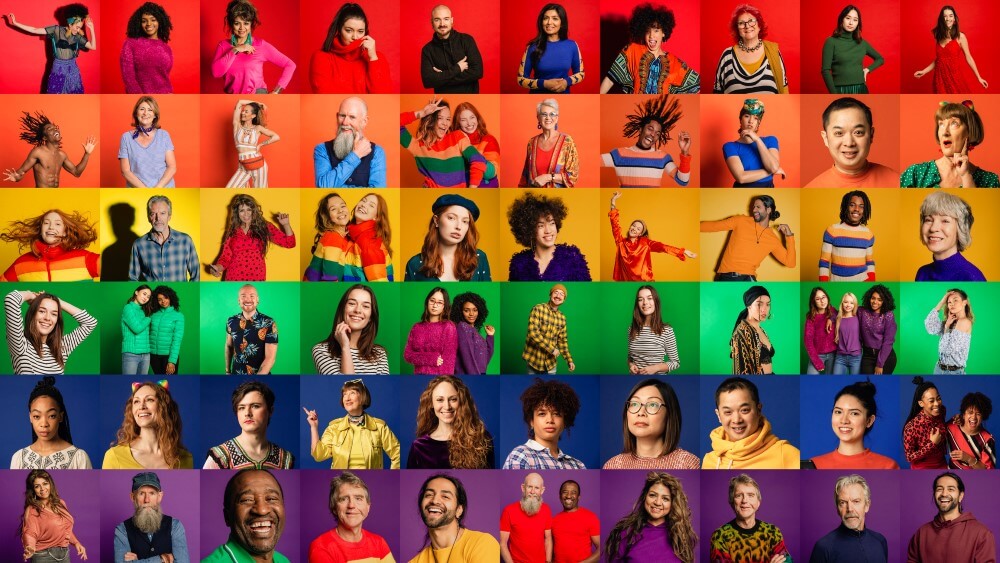A guide to personal pronouns
05 March 2021

To help us remain an inclusive and welcoming organisation, we are focusing on education in the LGBTQIA+SB space for our team. We’ve noticed confusion around personal pronouns so we've put together an introduction to help foster understanding.
As a supporter of the LGBTQIA+SB community, Feros Care often celebrates events like Mardi Gras and marriage equality. In 2020 the team created the Pride Support Network, where LGBTQIA+SB people and allies come together to support and promote understanding more broadly across Feros Care.
To help us remain an inclusive and welcoming organisation, a big focus is education. With that in mind, in 2021 our Pride Support Network created a toolkit to help us understand, respect and celebrate the LGBTQIA+SB community, and to supplement our existing training.
Something we’ve noticed there is a lot of misunderstanding about is the use of personal pronouns – why, when and how to respectfully use them. If you’re unsure yourself, here’s some tips.
Understanding gender
Because pronouns are generally gendered, it’s helpful to understand some concepts around gender initially.
Transgender
A transgender person is a person who does not identify as the gender they were assigned at birth. For instance, a person may have had their 'sex’ listed as female when they were born, however they do not identify as being female.
Cisgender
A cisgender person is a person who identifies as the gender they were assigned at birth. For instance, a person may have had their ‘sex’ listed as male when they were born, and they identify as a male.
Non-binary
Not everyone identifies strictly as male or female. Their gender identity might change at different times for instance. Some days they may identify as male, others female. They may describe themselves as genderfluid.
Personal pronouns
With an understanding of different gender identities, it becomes clear how personal pronouns are an important, even integral part of a person’s identity.
Most people know the female and male personal pronouns – She/Her/Hers and He/Him/His. These pronouns generally fit with the identity of someone who is cisgender. They can also fit with the identity of someone who is transgender.
HELPFUL HINT: DON’T ASSUME! It’s best not to assume. Neither gender presentation (whether a person looks male or female) nor gender identity are an indication of someone’s personal pronouns. The only way to know is to ask. We’ll discuss respectful ways to ask about pronouns soon!
You may also be familiar with the use of the pronouns They/Them/Theirs used in the singular. These pronouns may be comfortably used by people who identify as nonbinary. The pronouns don’t indicate gender.
HELPFUL HINT: IS GRAMMAR THAT IMPORTANT? Some people feel odd using they/them/theirs in the singular. True, its use in this way isn’t strictly grammatically correct. However, consider the discomfort of the person if their identity isn’t respected, and remember that language, too, evolves.
There are also several relatively new pronouns that you may have seen come into use. These include:
Subject | Object | Pronoun | Pronunciation |
Ze | Hir | Hirs | Zhee/Here/Heres |
Ze | Zir | Zirs | Zhee/Zhere/Zheres |
Xy | Xem | Xyr | Zhee/Zhem/Zhere |
HELPFUL HINT: HONORIFICS. Did you know there is a non-gender specific honorific in use? It’s Mx – pronounced ‘mix’ or ‘mux’. This can replace Mr/Mrs/Miss/Master/Ms.
Now that we have a grasp on some of the important concepts around gender identity and personal pronouns, let’s look at some tips on how to apply these in everyday life.
Top tips for respecting personal pronouns
Normalise pronouns
An easy way to get people thinking about pronouns is to share yours. You can add them in your email signature, and in your social media bios. Even if you are a cisgender man or woman, and your pronouns are he/she, letting people know what they are helps others consider pronoun use, and signals that you are personal pronoun friendly.
Ask
Ask everyone their pronouns – not just people you think may be non-binary or transgender. This may be a little out of your comfort zone, but it’s another step toward normalising personal pronoun respect. Use your discretion and ask privately where appropriate, depending on the circumstances.
Practice
The only way to get comfortable with personal pronouns, particularly nonbinary pronouns, is to constantly use them. Practice, practice, practice.
Say sorry
Mistakes will happen. If you accidentally use the wrong pronouns, apologise and use their stated personal pronouns moving forward - the best apology is to not do it again!
Correct
You may hear someone use the incorrect pronouns of a mutual friend or colleague. Simply let them know what their pronouns are.
Non-binary greetings
Try to use non-gendered language when you’re greeting a group of people. You could say ‘friends’, ‘team’ or ‘folks’ instead of ‘guys’, ‘ladies’ or ‘gents’.
It's personal
Get comfortable that there are no hard and fast rules around personal pronouns. What works for one person won’t for another.
Resources
This is meant as an introduction to the subject of gender and personal pronouns, created to foster understanding. We believe it’s always best to talk with, and most importantly listen to, people in the LGBTQIA+SB community to be a supportive ally. Below are some suggestions for further reading and listening.
LGBTA Wiki
Podcasts
- The Gender Rebels
- This Way Out
- Transition Transmission
- History is Gay
- Queery
- Naked Inside & Out
- Femme, Collectively